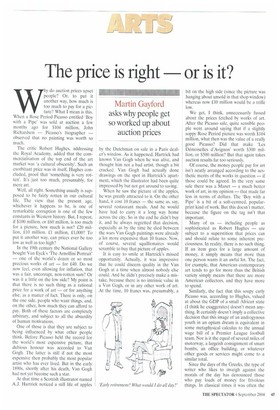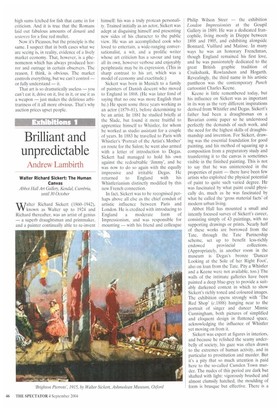The price is right or is it?
Martin Gaylord asks why people get so worked up about auction prices
Why do auction prices upset people? Or, to put it another way, how much is too much to pay for a picture? What I mean is this. When a Rose Period Picasso entitled 'Boy with a Pipe' was sold at auction a few months ago for S104 million, John Richardson — Picasso's biographer — observed that no painting was worth so much.
The critic Robert Hughes, addressing the Royal Academy, added that the commercialisation of the top end of the art market was 'a cultural obscenity'. Such an exorbitant price was in itself, Hughes concluded, proof that 'something is very rotten'. It's just too much, presumably, for mere art.
Well, all right. Something usually is supposed to be fairly rotten in our cultural life. The view that the present age, whichever it happens to be, is one of remarkable corruption is one of the few constants in Western history. But, I repeat, if $100 million, or £60 million, is too much for a picture, how much is not? £20 million, £10 million. £1 million, £1,000? To put it another way, can prices ever be too low as well as too high?
In the 19th century the National Gallery bought Van Eyck's The Arnolfini Portrait' — one of the world's dozen or so most precious works of art — for £40. Do we now feel, even allowing for inflation, that was a fair, uncorrupt, non-rotten sum? Or was it a little on the low side? My point is that there is no such thing as a rational price for a work of art — or for anything else, as a matter of fact. There is only, on the one side, people who want things, and, on the other, how much they can afford to pay. Both of these factors are completely arbitrary, and subject to all the absurdity of human motivations.
One of those is that they are subject to being influenced by what other people think. Before Picasso held the record for the world's most expensive picture, that dubious honour was accorded to Van Gogh. The latter is still if not the most expensive then probably the most popular artist who has ever lived. But in the early 1890s, shortly after his death, Van Gogh had not yet become such a star.
At that time a Scottish illustrator named A.J. Hartrick noticed a still life of apples by the Dutchman on sale in a Paris dealer's window. As it happened, Hartrick had known Van Gogh when he was alive, and thought him not a bad artist, though a bit cracked. Van Gogh had actually done drawings on the spot in Hartrick's apartment, which the illustrator had been quite impressed by but not got around to saving.
When he saw the picture of the apples, he was greatly attracted to it. On the other hand, it cost 10 francs — the same as, say, several restaurant meals. And he would have had to carry it a long way home across the city. So in the end he didn't buy it, and he always regretted that decision, especially as by the time he died between the wars Van Gogh paintings were already a lot more expensive than 10 francs. Now, of course, several squillionaires would scramble to buy that picture of apples.
It is easy to smile at Hartrick's missed opportunity. Actually, it was impressive that he could discern quality in the Van Gogh at a time when almost nobody else could. And he didn't precisely make a mistake, because there is no intrinsic value in a Van Gogh, or in any other work of art. At the time, 10 francs was, presumably, a
bit on the high side (since the picture was hanging about unsold in that shop window) whereas now £10 million would be a trifle low.
We get, I think, unnecessarily fussed about the prices fetched by works of art. After the Picasso sale, quite sensible people went around saying that if a slightly soppy Rose Period picture was worth $104 million, what then was the value of a really good Picasso? Did that make 'Les Demoiselles d'Avignon' worth $300 million, or $500 million? But that again takes auction results far too seriously.
Of course, the money people pay for art isn't neatly arranged according to the aesthetic merits of the works in question — if those could be agreed. In the very same sale there was a Manet — a much better work of art, in my opinion — that made far less in terms of dollars. The 'Boy with a Pipe' is a bit of a soft-centred, popularprint kind of work. But this doesn't matter, because the figure on the tag isn't that important.
Many of us — including people as sophisticated as Robert Hughes — are subject to a superstition that prices can and should relate to some inherent preciousness. In reality, there is no such thing. If an item goes for a large amount of money, it simply means that more than one person wants it an awful lot. The fact, for example, that American contemporary art tends to go for more than the British variety simply means that there are more American collectors, and they have more to spend.
Similarly, the fact that this soupy early Picasso was, according to Hughes, valued at about the GDP of a small African state (I think he exaggerates) doesn't mean anything. It certainly doesn't imply a collective decision that this image of an androgynous youth in an opium dream is equivalent in some metaphysical calculus to the annual wage bill of a Premier League football team. Nor is it the equal of several miles of motorway, a largeish consignment of smart bombs, an office building, or whatever other goods or services might come to a similar total.
Since the days of the Greeks, the type of writer who likes to inveigh against the morals of the day has denounced those who pay loads of money for frivolous things. In classical times it was often the high sums fetched for fish that came in for criticism. And it is true that the Romans laid out fabulous amounts of denarii and sesterces for a fine red mullet.
Now it's Picassos, but the principle is the same. I suspect that in both cases what we are seeing is, in reality, evidence of a lively market economy. That, however, is a phenomenon which has always produced horror and outrage in certain observers. The reason, I think, is obvious. The market controls everything, but we can't control — or fully understand — it.
That art is so dramatically useless — you can't eat it, drive on it, live in it, or use it as a weapon — just makes the delirious arbitrariness of it all more obvious. That's why auction prices upset people.



































































 Previous page
Previous page